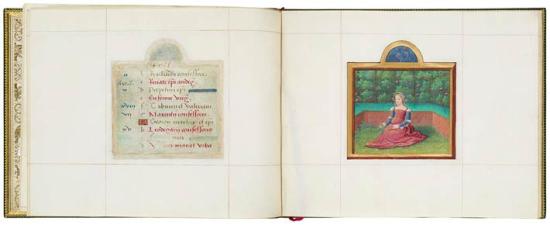
Album of Calendar Miniatures
Illuminated by the Master of Claude de France
Purchased as the gift of the Virginia M. Schirrmeister Charitable Lead Trust, Mrs. Alexandre P. Rosenberg, Gifford Combs, James H. Marrow, Melvin R. Seiden, Salle Vaughn, and Sotheby's, and on the E. Clark Stillman Fund, in memory of Charles Ryskamp, 2010
Seated in a rose garden, a girl weaves a flower garland for her suitor. She is the illustration for the month of May from a prayer book, the calendar illustrations of which were excised during the nineteenth century and inserted into this album. The maiden is dressed in the new Italianate fashion. Her gown is cut with a low, square neck revealing the top of her linen smock. Her sleeves are in two parts, tied together and to the gown with gold laces. The linen of her smock pokes through at her shoulders, elbows, and the slits of the lower sleeve.
Dawn of the Renaissance
After the coronation of François I in 1515, a fundamental change came about in French art and culture. The king, known even during his lifetime as "father of the arts," was a connoisseur who imported major Italian artists (Leonardo da Vinci among the first) and artworks to France on a grand scale. Italian fashions, which began to appear during the reign of his predecessor, Louis XII, flowered under François.
For men, the long bulky gowns of the previous period disappeared, replaced by short ones with wide shoulders. Worn open and with short sleeves, the new gown showed off the slashed front and sleeves of Italianate doublets that offered sexy glimpses of the man's linen shirts. Low-brimmed hats, worn at jaunty angles, were decorated with slanted ostrich feathers. Shoes were square-toed, their uppers sometimes slashed.
Women, too, adopted Italian styles. Their gowns, featuring low, square necks, provided glimpses of their linen smocks. Sleeves also displayed the smock: these were now often worn loosely tied to the bodice or split into two parts and slit along the underside.
